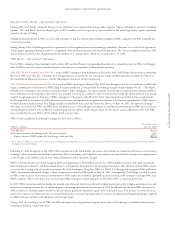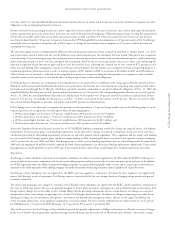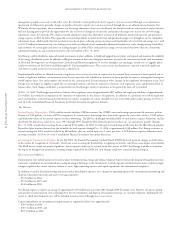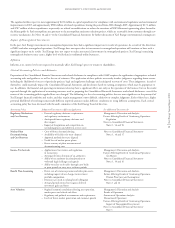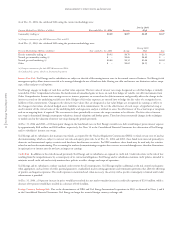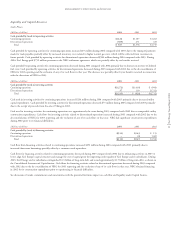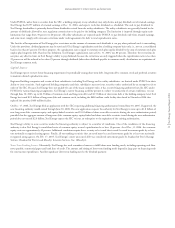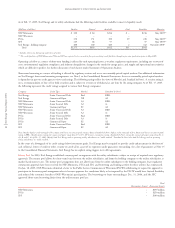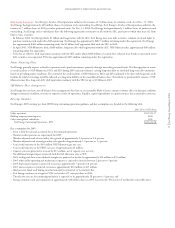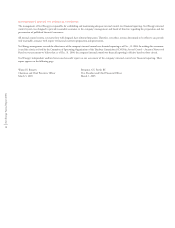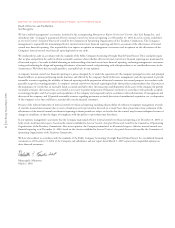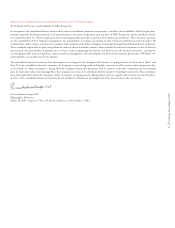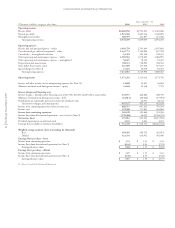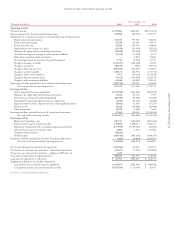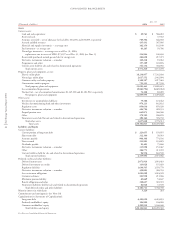Xcel Energy 2004 Annual Report Download - page 37
Download and view the complete annual report
Please find page 37 of the 2004 Xcel Energy annual report below. You can navigate through the pages in the report by either clicking on the pages listed below, or by using the keyword search tool below to find specific information within the annual report.
MANAGEMENT’S DISCUSSION and ANALYSIS
Xcel Energy Annual Report 2004
35
Under PUHCA, unless there is an order from the SEC, a holding company or any subsidiary may only declare and pay dividends out of retained earnings.
Xcel Energy had $397 million of retained earnings at Dec. 31, 2004, and expects to declare dividends as scheduled. The cash to pay dividends to
Xcel Energy shareholders is primarily derived from dividends received from the utility subsidiaries. The utility subsidiaries are generally limited in the
amount of dividends allowed by state regulatory commissions to be paid to the holding company. The limitation is imposed through equity ratio
limitations that range from 30 percent to 60 percent. All utility subsidiaries are required under PUHCA to pay dividends only from retained earnings,
and some must comply with covenant restrictions under credit agreements for debt to total capitalization ratios.
The Articles of Incorporation of Xcel Energy place restrictions on the amount of common stock dividends it can pay when preferred stock is outstanding.
Under the provisions, dividend payments may be restricted if Xcel Energy’s capitalization ratio (on a holding company basis only, i.e., not on a consolidated
basis) is less than 25 percent. For these purposes, the capitalization ratio is equal to common stock plus surplus divided by the sum of common stock plus
surplus plus long-term debt. Based on this definition, Xcel Energy’s capitalization ratio at Dec. 31, 2004, was 80 percent. Therefore, the restrictions do
not place any effective limit on Xcel Energy’s ability to pay dividends because the restrictions are only triggered when the capitalization ratio is less than
25 percent or will be reduced to less than 25 percent through dividends (other than dividends payable in common stock), distributions or acquisitions of
Xcel Energy common stock.
Capital Sources
Xcel Energy expects to meet future financing requirements by periodically issuing short-term debt, long-term debt, common stock and preferred securities
to maintain desired capitalization ratios.
Registered holding companies and certain of their subsidiaries, including Xcel Energy and its utility subsidiaries, are limited under PUHCA in their
ability to issue securities. Such registered holding companies and their subsidiaries may not issue securities unless authorized by an exemptive rule or
order of the SEC. Because Xcel Energy does not qualify for any of the main exemptive rules, it has received financing authority from the SEC under
PUHCA for various financing arrangements. Xcel Energy’s current financing authority permits it, subject to satisfaction of certain conditions, to issue
through June 30, 2005, up to $2.5 billion of common stock and long-term debt and $1.5 billion of short-term debt at the holding-company level. Xcel
Energy has issued $2.2 billion of long-term debt and common stock, including the $600 million credit facility that closed in November 2004 that
replaced the previous $400 million facility.
On Dec. 17, 2004, Xcel Energy filed an application with the SEC requesting additional financing authorization beyond June 30, 2005. If approved, the
new financing authority would extend through June 30, 2008. The new application requests the authority for Xcel Energy to issue up to $1.8 billion of
new long-term debt, common equity and equity-linked securities and $1.0 billion of short-term debt securities during the new authorization period,
provided that the aggregate amount of long-term debt, common equity, equity-linked and short-term debt securities issued during the new authorization
period does not exceed $2.0 billion. Xcel Energy expects the SEC to issue an order prior to the expiration of the existing authorization.
Xcel Energy’s ability to issue securities under the financing authority is subject to a number of conditions. One of the conditions of the financing
authority is that Xcel Energy’s consolidated ratio of common equity to total capitalization be at least 30 percent. As of Dec. 31, 2004, the common
equity ratio was approximately 42 percent. Additional conditions require that a security to be issued that is rated, be rated investment grade by at least
one nationally recognized rating agency. Finally, all outstanding securities that are rated must be rated investment grade by at least one nationally
recognized rating agency. On Feb. 17, 2005, Xcel Energy’s senior unsecured debt was considered investment grade by Standard & Poor’s Ratings
Services (Standard & Poor’s) and Moody’s Investors Services, Inc. (Moody’s).
Short-Term Funding Sources Historically, Xcel Energy has used a number of sources to fulfill short-term funding needs, including operating cash flow,
notes payable, commercial paper and bank lines of credit. The amount and timing of short-term funding needs depend in large part on financing needs
for construction expenditures. Another significant short-term funding need is the dividend payment.


